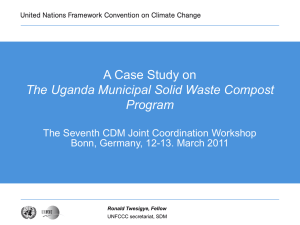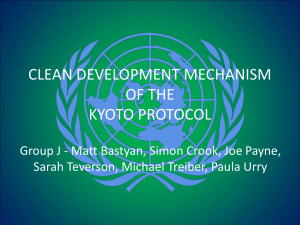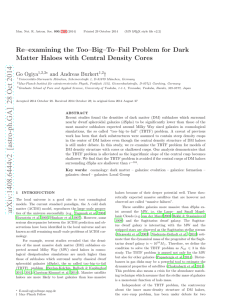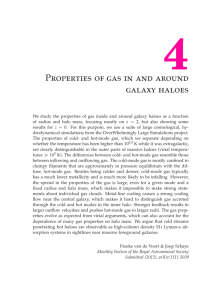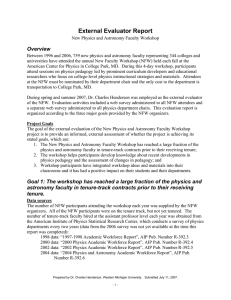Presentazione di PowerPoint - Max-Planck
advertisement
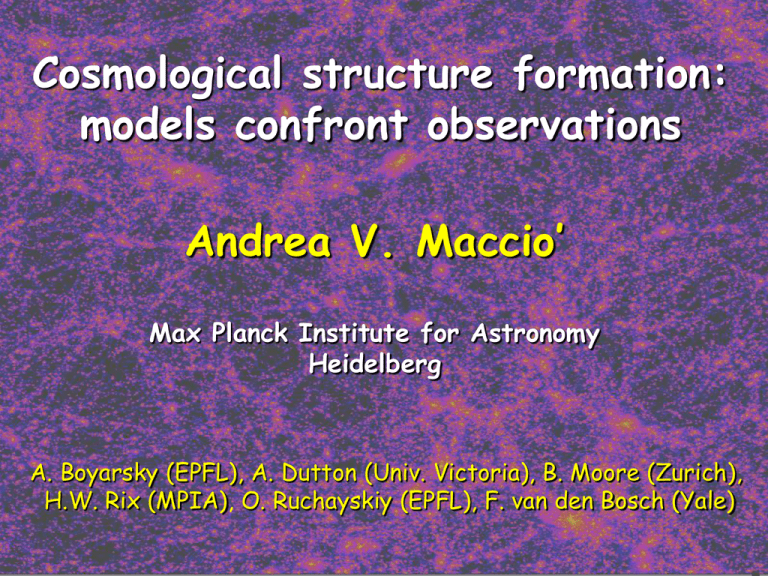
Cosmological structure formation: models confront observations Andrea V. Maccio’ Max Planck Institute for Astronomy Heidelberg A. Boyarsky (EPFL), A. Dutton (Univ. Victoria), B. Moore (Zurich), H.W. Rix (MPIA), O. Ruchayskiy (EPFL), F. van den Bosch (Yale) Is (L)CDM the right model? Theory-Models Observations How to compare these two pictures? Overview 1) Why CDM? 2) How to study DM distribution -> Nbody Simulations 3) DM haloes properties: density profile 4) Comparison with observations I: Rotation Curves 5) A new Universal quantity: DM column density 6) Comparison with observations II New method -> new evidence for DM 7) Conclusions Why CDM? Explains flat rotation curves of spiral galaxies Reproduces Large scale structure Van Albada+ 1985 (C)DM required by Virial Theorem in galaxy clusters. and by Strong Lensing Analysis Springel+ 06 CMB WMAP mission m bar Universe’s ingredients Non relativistic Matter: CDM + baryons (85% -15%) Radiation: today negligible (ρ~a-4) Dark Energy: ~70-75% Does not cluster (at least on scales <10-100 Mpc) Curvature: likely to be zero (CMB + Inflation) Structure formation ruled by DM with DE setting the background How to study/follow the Universe: why numerical simulations? Initial conditions from the CMB T T ( cluster center ) 10 5 10 orders of magnitude (break down of linear theory) -> Numerical simulations 10 5 The N-body: Pure Gravity Cold Dark Matter: non relativistic, collisionless fluid of particles f t p ma 2 f m f p f f (x, p, t) ( x, t ) 0 Boltzmann collisionless equations (Vlasov Equation) in an expanding Universe Phase Space density 3 f ( x, p, t )d p ( x , t ) 4 Ga [ ( x , t ) ( t )] 2 2 Matter density We want to solve the equations of motions of N particles directly. The N particles are a Monte-Carlo realization of the true initial conditions. Particles for a numerical cosmologist Modern computer can handle more than 108 particles 1 Simulation Volume: 200 h Mpc cr 2 . 7755 10 11 h 2 M mp V Np Mpc sun cr m 6 . 66 10 3 9 Our particles have the same mass of a dwarf galaxy… High resolution simulation of a single halo object: m p 10 M sun Galaxies (recent simulations mp~1000 Msun) 5 m p 10 M sun Clusters 7 Initial Conditions (ICs) z~1000 Initial Conditions The Power Spectrum evolves according linear theory untill: P ( k ) Ak T ( k , z ) n 2 0 . 2 z ~ 20 50 T(k,z) provided by linear theory Then we should obtain a realization of this P(k) using particles: Zel’dovich Approximation r ( q , t ) a ( t ) q b ( t ) S ( q ) S (q ) 0 (q ) 0 (q ) a k cos( kq ) b k sin( kq ) k a k , bk P( k ) Gauss ( 0 ,1) k 2 Density wave Zeldovich Velocities and Positions are linked together r ( q , t ) a ( t ) q b ( t ) S ( q ) S (q ) 0 (q ) 0 (q ) a k k cos( kq ) b k sin( kq ) a k , bk P( k ) Gauss ( 0 ,1) k 2 50 Mpc – 3003 part log [ 1 : 0 ] z=25 Maccio’+06,07 z=0 log [ 2 : 5 ] Structure Formation in the WMAP5 cosmology (comoving coordinates - www.mpia.de/~maccio/movies) Formation of a cluster in the WMAP5 cosmology (comoving coordinates www.mpia.de/~maccio/movies) High-Res Simulation of a single object Distribution of particles of different masses (i.e. different symbols) at z=10. (figure from Klypin+01) Refinement: Re-simulating one halo with better mass resolution 3 M pc 300 M pc 36.000 DM satellites (within 300 kpc) 25 Millions part Highest res simulation ever made (Diemand+08 Maccio’+10) Finding Halos: Spherical Over-density algorithm: Virial density contrast fixed by linear theory: Dvir = 220*background 180 Mpc For each halo: Mvir Rvir Density profiles of CDM structures (r ) cr c ( r / rs )( 1 r / rs ) 2 NFW1997 1997 NFW Concentration C=Rvir/rs Density Navarro, Frenk & White 1997 2 free parameters: • rs and δc Radius or • c and Mvir. NFW1997: Works for all cosmological models Shape is preserved only the fitting parameters change NFW profile II NFW velocity profile Rotation curve Circular velocity profile V c ( R ) GM ( R ) R Concentration Mass relation Mass and concentration are related. Concentration is linked to the density of the universe at time of formation. Small haloes form earlier -> the universe was denser at high z -> small haloes are more concentrated Maccio’+07 Maccio’+08 This relation strongly depends on the cosmological model (r ) Inner density slope Navarro, Frank & White (1997) : Moore et al. (1999) : 1 .0 cr c ( r / rs )( 1 r / rs ) 1 .5 Moore+ 1999 Springel+08 Springel+08 No asymptotic slope detected so far 2 Observational Results Observations provide velocity profiles that are then converted in density profiles Low Surface Brightness Galaxies LSB: Dark matter dominated, stellar population make only a small contribution to the observed rotation curve Rotational velocity from HI and Hα Rotational velocity proportional to enclosed mass V c ( R ) GM ( R ) R Swaters+ 2001 de Block+ 2001 30 LSB/Dwarf galaxies analyzed de Blok+ 2001a 30 LSB/Dwarf galaxies analyzed NWF gives a poor fit Concentrations too low or too low mass to light ratio Theoretical prediction Ωm=0.3 σ8=0.95 Concentrations distribution de Blok+ 2001b Density profile of LSB galaxies Core NFW Moore Swaters+ 01 Observing Simulations Spekkens+05 Density slope determined by 2-3 points They tried to recover the density profile slope of DM haloes with the same pipeline used for observations All the possible “observational” biases favor a cored profile Is the question solved? Not at all High resolution observations of single objects do show deviations from NFW Gentile+05 Gentile+06 NGC3741 C=3 (r ) 0 r0 3 ( r r0 )( r r ) 2 Burkert profile 2 0 DDO47 Matter surface density: New problems for CDM? Burkert profile (r ) 0 r0 Donato+09 Gentile+09 Nature 3 ( r r0 )( r r0 ) 2 2 MOND!! Is this constant surface density a problem for CDM? Can we learn something from it? Dark Matter surface column density ( r ) BURK 0 r0 3 ( r r0 )( r r0 ) 2 2 S is insensitive to the details of the density profile We can compute S for real galaxies and for DM haloes S: a new universal quantity Boyarsky+09 We collected from literature profiles for 372 (295) objects (Burkert, NFW and ISO) Donato+09 M DM R 200 0 4 r DM ( r ) dr 2 Let’s think Bigger MDM instead of MB no restriction to use only (spiral) galaxies Spirals Spirals Spirals Spirals Clusters Clusters Elliptical Clusters Elliptical Groups Groups Spirals Spirals Clusters Clusters Elliptical Elliptical Groups Groups Let’s think even bigger!! Satellites are more concentrated than isolated haloes (Maulbetsch+06, Springel+ 08) DM haloes 25,000 DM haloes from WMAP5 simulations (Maccio’+08) MDM: 1010 – 1015 Msun Spirals Clusters Elliptical Groups dSphs (MW) DM haloes c/M toy model M+08 Spirals Clusters Elliptical Groups dSphs DM haloes c/M toy model M+08 Aquarius sim. satellites 9 orders of magnitude!!! This is definitely a Nature plot • NO constant surface density, artifact of log/log • New quantity: S allows direct comparison of theory and data • CDM reproduces obs. on 9 (nine) orders of magnitude • Only CDM works on all scales (no MOND for cluster) • One more evidence for the presence of DM Boyarsky et al. 2009, arXiv:0911.1774 Conclusions 1) Nbody sims best tool to study DM distribution 2) Solid predictions for CDM distribution. 3) To compare obs and sims unbiased quantities are needed 4) Rotation curves seems to prefer cored profiles (?) What is the effect of baryons (see Governato+09 Nature) 5) We present a new, fully unbiased parameter S. Astonishing agreement between obs and sims, 6) We do need CDM!




